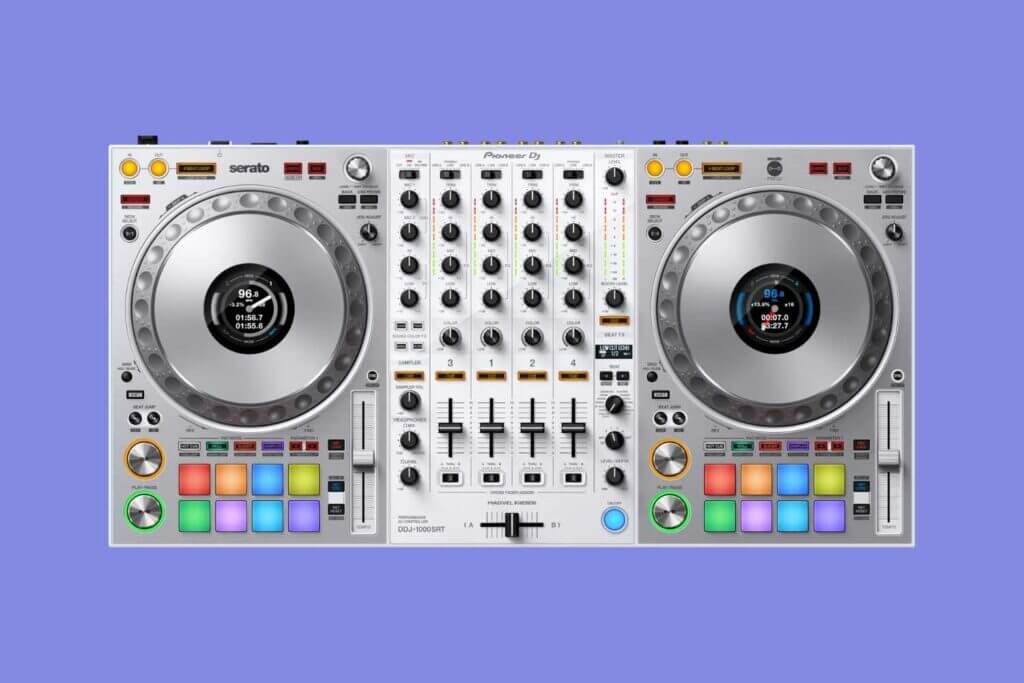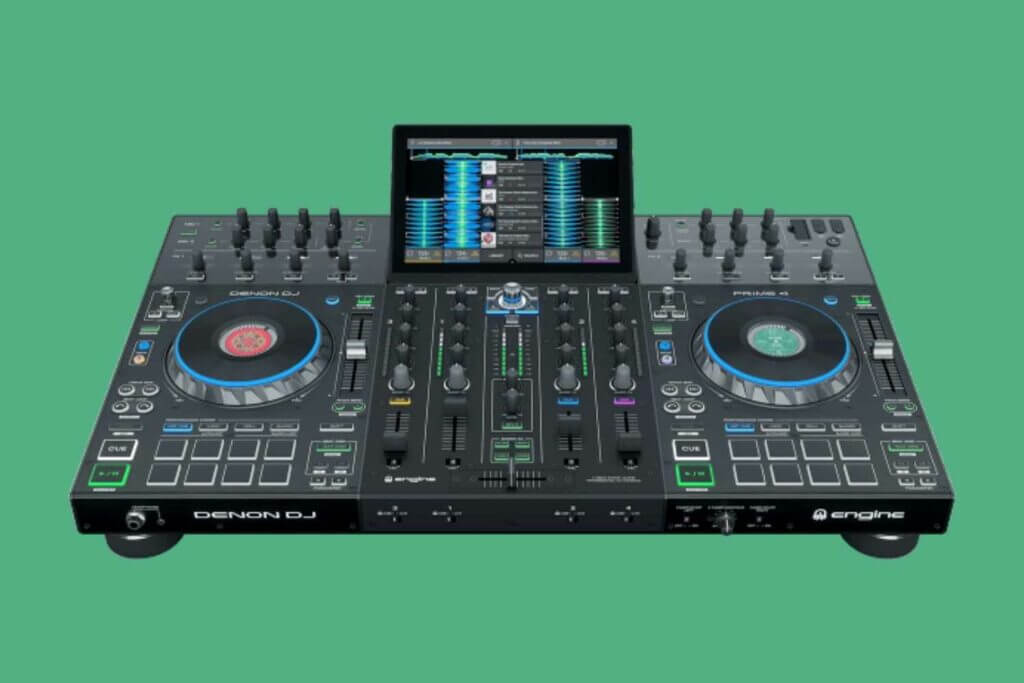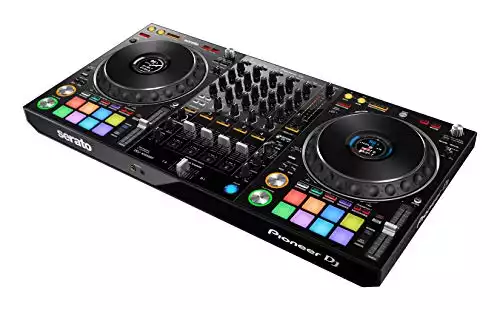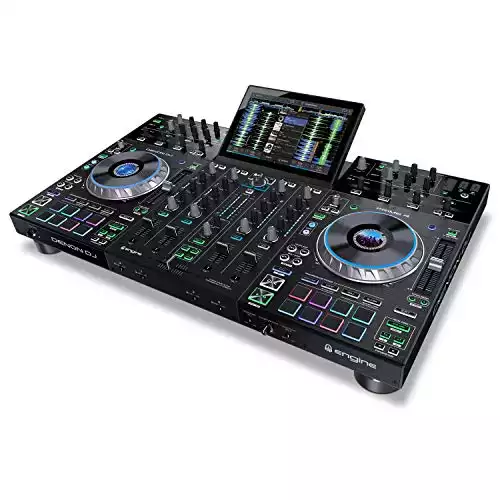Full emersion vs. connection-free
Two of the more impressive and capable DJ equipment brands out there today are none other than Pioneer DJ and Denon DJ. Though many people generally tend to view Pioneer DJ as the superior of the two, the reality is that both companies are much closer in quality than you’d think.
A prime example of this is none other than two of their most well-known controllers, the DDJ-1000SRT and the Denon DJ Prime 4.
Denon DJ Prime 4 Vs DDJ-1000SRT: Overview
Both of these controllers make a point of offering a high-quality, compelling, and complete DJ experience at both the hobby and professional levels, and both are priced relatively reasonably based on what they offer.
The big difference between the two more or less deals with how one focuses on a fully immersive performance while the other prides itself on being entirely standalone with an “all-in-one” connection-free experience.
In this breakdown, we’ll take a look at both of these controllers to determine which is ideal for most practicing DJs out there.
Is it better to have everything available while needing a computer on-hand, or an entirely computer-free performance that may not give you everything you need?
Let’s start with the DDJ-1000SRT.
Pioneer DJ DDJ-1000SRT Explained
Starting with the more famous of the two, Pioneer DJ’s DDJ-1000SRT has made a lot of news and headway, especially after its predecessor, the original DDJ-1000, came and revolutionized the DJ landscape.
While the 1000SRT isn’t quite as groundbreaking (literally just a Serato version), it still carries with it nearly all of the prestige and impressive capabilities that Pioneer DJ is so famous for.
The DDJ-1000SRT is fairly impressive in size and build, with a 27.8-inch (706.12mm) width, a 2.89-inch (73.4mm) height, and a 14.2-inch (360.68mm) depth.
It weighs in at 13.23lbs (6kg) and comes with 4 playable channels for maximum performance.

Read this next: Pioneer DDJ-1000SRT: Best Serato Controller Ever?
What We Like:
- Comes With Serato DJ Pro
- Full-Size Jogwheels
- Intricate & Smooth Fader
- Club-Style Layout
- 4-Channel Input Connection
Comes With Serato DJ Pro
First off, we have to talk about the inclusion of the Serato DJ Pro software. This was such a huge factor when it came to the 1000SRT, that it’s the reason the controller exists in the first place.
While not quite native to the hardware the same way the Rekordbox software is to the original DDJ-1000, the Serato DJ Pro software still is an incredible inclusion that is the oldest and most well-developed option out there.
Many features can only be accessed while on Serato DJ Pro, essentially making a quality controller that much better when in use.
Also, the fact that you get everything pretty much immediately is a sell on its own, especially considering the same is not true for the Prime 4.
Full-Size Jogwheels
In addition to the impressiveness that is Serato DJ Pro, we also need to talk about the inclusion of the controller’s full-size jogwheels.
Not only are they impressive all on their own (high-quality material, full adjustable resistance, feels great when playing with, etc.) but each also comes with its display screen.
The on-jog display is in full color and keeps track of your BPM, playback time, and playback position. Simply put, it presents any and all pertinent data and information you’ll need for optimal performance.
Intricate & Smooth Fader
When it comes to the 1000SRT and its different features, we have to talk about its impressive MAGVEL FADER.
This fader sits right in the center with the rest of the mixing features and is immediately noticeable for its durable and smooth build. I’ve had a chance to play with other faders, and, even now, the DDJ-1000SRT is in the top brass for quality.
It doesn’t feel cheap or plasticky, instead having a smoother “gliding” effect when moving from left to right. The fader can retain its integrity after 10 million movements, essentially never feeling “loose” or flimsy.
Club-Style Layout
Meant to go along with professional club-performing CDJs and controllers, the 1000SRT’s layout holds both decks on either side of the controller with the mixer and its effects square in the middle.
This is the style most used even today by night club DJs, making it ideal for someone looking to transition to performing at larger and more established venues.
4-Channel Input Connection
Last but not least, the DDJ 1000SRT comes with 4-channel input options to play with and connect to, potentially working with 4 devices simultaneously.
These devices can range from separate CDJs and turntables to a dedicated mixer, to even things like a PA speaker or set of microphones.
If you’re interested, you can also tie them to a smartphone or tablet through the AUX port.
What We Don’t Like:
- Must Be Connected To a Computer
- Display Isn’t Visually Pleasing
- Jogwheels Are Potentially A Hassle To Transition Into
Must Be Connected To a Computer
The biggest “challenge” to the DDJ-1000SRT is the fact that it requires an established connection to your laptop computer to properly use.
While this is the case for pretty much all controllers out there, the fact that it’s not required for the Prime 4 says that it didn’t “need” to be required here.
Still, carrying your laptop around isn’t the end of the world and you do have more available features as a result.
I just wish Pioneer DJ had it as an option, even if it wasn’t one people always (or even mostly) used.
Display Isn’t Visually Pleasing
More of a smaller nitpick, one thing you’ll notice with the 1000SRT is the fact that its on-jog display isn’t particularly appealing from an aesthetic standpoint.
Pretty much, it’s just all the key info you need for your performance. This is a bit different with the Prime 4 and I will say that I did miss their inclusion of a track’s album art compared to the 1000SRT just putting out data.
I think a good compromise would have been an option to switch between the two or to have a button you can press to immediately display the BPM and other pieces of info.
This is especially the case when you think about the fact that you’re only going to take glances while performing.
Jogwheels Are Potentially A Hassle To Transition Into
While “hassle” may be a bit of an exaggeration, the fact of the matter is that, while I love the mechanical jog wheel setup, I can’t say that it’s universally revered. This is primarily because most DJ controllers out there tend to use capacitive jogwheels instead.
These are more common and, as such, can be difficult to transition out of to the mechanical setup.
Generally, I’ve found that mechanical jogwheels are superior and worth the swap. That said, if you’re getting along fine with capacitive, I can understand how it may be an unnecessary switch.
Read this next: Pioneer DJ DDJ 1000 Vs DDJ 1000SRT: What Exactly is the Difference?
Verdict
There’s not much I can say that hasn’t already been said about the DDJ-1000SRT. This is a stellar controller that is built and designed to get you ready for the main stage with the “big boys”.
Currently, the 1000SRT is ideal for DJs that want something that has wider appeal amongst those in the more professional circuit, though its lack of an “all-in-one” standalone feature does make it a bit of an annoying prospect, especially if you already have a ton of things you have to carry (and the fact that CDJs are also standalone).
There’s also the lack of custom art to look at on your jogwheel display.
Sure, its inclusion was never going to be groundbreaking or earth-shattering, but it would certainly have been nice to see.
Denon DJ Prime 4 Explained
While Pioneer DJ’s DDJ-1000SRT may not need an introduction, the same may not be true for Denon’s DJ Prime 4.
Coming out around the same time as the 1000SRT, the Denon DJ Prime 4 was meant to be a revolutionary device in its own right, pulling more from the CDJ’s standalone feature instead of its layout and design.
The Prime 4 is a bit bigger and bulkier than the 1000SRT with a weight of 21.34lbs (9.7kg). It has a 28.68-inch (728.47mm) width, a 19.56-inch (496.82mm) depth, and a 4.08-inch (103.63mm) height.
The controller is a 4-channel device with touchscreen capabilities, access to both Serato DJ Pro and Virtual DJ software types, and a dedicated XLR Zone output feature that allows you to simultaneously play in two separate rooms.

Read this next: Denon Prime 4: How Awesome Is It Actually?
What We Like:
- Larger Build
- Completely Standalone
- 4-Deck Control & XLR Zone Output
- Advanced Touchscreen Capabilities
- Multiple Software Compatibility
- Can Link To Music Streaming
- Customizable Jogwheel Visuals
Larger Build
The Denon DJ Prime 4 is a bit heftier and larger compared to the 1000SRT. Both devices are made with similar quality material, meaning that, while it is slightly more difficult to travel with, the Prime 4 is very sturdy and durable.
Unless you’re trying to do some damage, this thing can take the accidental bump or smack without even flinching.
Completely Standalone
Probably the biggest selling point for the Prime 4, it draws heavily from CDJs in that it is an all-in-one controller that doesn’t require an additional laptop to perform.
This is something you don’t ever really see with controllers, so it gets a lot of points for that alone.
The features available when not connected to a computer are fairly limited, yes, but that still doesn’t take away from the fact that you are truly mobile compared to virtually any other controller on the market.
4-Deck Control & XLR Zone Output
We talked about 4-deck control with the DDJ 1000SRT controller. Here, many of the same things apply. What takes it that extra step forward is its dedicated XLR Zone output feature.
This allows you to not only run 4 different devices simultaneously but also allows you to send music out to an entirely different room. Essentially, you can be partying and performing in one room while also DJing in a relaxed and chill setting in the other.
This is a feature wholly unique to the Prime 4 and a serious game-changer for most DJs that want a potentially broader and more diverse audience.
Advanced Touchscreen Capabilities
Another compelling factor with the Prime 4 is its 10.1-inch multi-gesture touchscreen. While the controller doesn’t include the same important and pertinent data on its jogwheels, that information is still available.
Instead of being available at a glance, however, it is on the controller’s center touchscreen device. Here, you can view each deck, the different waveforms, as well as many other important pieces of info.
From my experience, the touchscreen was pretty responsive and, while not quite on the level of a smartphone or tablet, it still feels great to play with and is easy to navigate.
Multiple Software Compatibility
Unlike the DDJ-1000SRT controller, which makes its claim to fame the use of Serato DJ Pro, Denon’s DJ Prime 4 can be used with the same Serato DJ Pro as well as the Virtual DJ software.
Considering both of these software types have their strengths and weaknesses, the fact that you can choose which of the two options works best really says a lot.
Denon DJ also offers their Engine Prime DJ software which is certainly a bit of kit to watch out for in the future.
Can Link To Music Streaming Platforms
Utilizing its built-in Wi-Fi feature as well as its Ethernet port, the Prime 4 can connect to many of the top music streaming platforms.
You can also directly access your cloud storage.
This is all without the use of a computer. When used alongside the various software options, the Prime 4 is truly an “all-in-one” controller that can be used without any other devices.
Customizable Jogwheel Visuals
Last on the list is the customizable jog wheel visuals offered. While not the same size as the 1000SRT controller, the Prime 4’s slightly smaller wheels have a fully customizable RGB light to give your controller some personality.
Just as well, the jogwheels also allow you to display the track’s album artwork or customized art at its center, something you don’t see with the 1000SRT.
The jogwheels are also capacitive. This means that they aren’t quite as quality as the mechanical jogwheels but are more widely used. This means fewer people will need to transition over to a new jogwheel type, essentially making it more accessible.
What We Don’t Like:
- More Expensive
- Doesn’t Have As Many Features Or FX
- Layout Isn’t Great For Professional DJs
More Expensive
When it comes down to price, while both are somewhat reasonably priced based on what they offer, it’s clear that the DDJ-1000SRT was more focused on making something slightly more affordable compared to the Prime 4, which seemed to want to make something extremely powerful and good-looking.
The issue is that the people who can afford the Prime 4 will be people who are likely going to take DJing seriously.
Those people, while interested in several different features, will be turned off by others. On the other hand, the 1000SRT is more attractive from a pricing standpoint while also giving professional DJs what they want in a controller.
Doesn’t Have As Many Features Or FX
Interestingly, while the Prime 4 does have a ton of fancy factors in its favor, it is surprisingly lacking in terms of the number of FX offers. Whereas the DDJ-1000SRT hosts at least 18 different FX features, the Prime 4 only has 14.
This isn’t even getting into the fact that the DDJ-1000SRT host’s numerous other FX options on its Serato software, making the number of feature differences even greater in this respect.
Still, it would be a lie to argue that the Prime 4 has “no” FX options. The reality is that they just have the key popular ones instead of a more varied and versatile set.
Layout Isn’t Great For Professional DJs
Despite taking the standalone aspect from most CDJs, the Prime 4 decided to keep things more traditional when it came to the layout.
This is great if you’re more of a gig or hobby-based DJ. However, if you’re trying to break into the club or high-end venue, you’d think they’d have put out a layout that was more in line with popular CDJs the same way that the 1000SRT did.
Read this next: Which DJs Use Denon DJ? (Answer: LOTS OF THEM!)
Verdict
When it comes to the Denon DJ Prime 4 controller, it does virtually everything right and respectfully. Issues like pricing and layout may be a bit of a sticking point, but overall, if you ended up getting the Prime 4, I can hardly imagine you a lot of complaining.
Which Is Best?
Oh, man! I’ve got to say that it’s really difficult to put a pin on which of these is truly the better of the two. On one hand, Pioneer DJ’s DDJ-1000SRT is perfect for those looking to get into the professional DJ field thanks to its CDJ-inspired layout, smaller and lighter build, and thorough Serato DJ Pro software features.
On the other hand, Denon DJ’s Prime 4 looks better, largely feels better, and has a ton of cool gizmos and additions that truly make it stand out.
I will say this; while I LOVED everything that Denon DJ’s Prime 4 had to offer (and I do mean love), it was hard for me to imagine those things as being game changers as a DJ.
If anything, they came across as super fun add-ons to a fairly standard controller, all at a hiked-up price.
I’ll put it like this (because this is pretty difficult), if you are someone that wants to be a professional DJ, go for the 1000SRT.
While it isn’t quite as “impressive” as the Prime 4, everything you get is things you’ll benefit from as a DJ. Similarly, if you want to pick the more affordable option, you should also pick DDJ-1000SRT.
Again, I love everything the Prime 4 offers. The problem is that very few of those things are going to be useful as a professional DJ while the price is a bit too high for a mobile DJ or one that views DJing as a hobby.
Ultimately, unless you have excess cash to burn for a DJ controller that’s more of a super fun toy than an actual work tool, I will have to say that Pioneer DJ’s DDJ-1000SRT is the better of the two controllers.
Denon DJ Prime 4 Vs DDJ-1000SRT: The Verdict
This was not an easy decision, primarily because the Prime 4 is an awesome controller. The reality is that it offers things you don’t need at a premium while ignoring some of the things that you do.
I love both of these controllers and I’ll probably end up getting the Prime 4 later on down the line.
However, if you need something good right now, you’re better off starting with the DDJ-1000SRT and going from there.






